Family: Ambystomatidae (Mole Salamanders)
Genus: Ambystoma (Mole Salamanders)
|

| 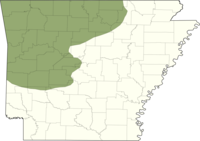
|
| Rare. Relatively large. Color a midnight blue with bold, narrow, yellowish "rings" (that do not extend onto the belly). Belly grayish to yellowish.
| 
|

| 
|
| Relatively large. Color a midnight blue with two rows of large, yellow spots on body and orangish spots on head. Belly gray.
|
|
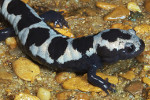
| 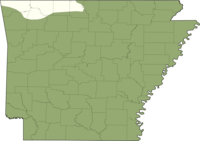
|
| Relatively large. Color a midnight blue with bold, broad, silvery-white crossbands (often forming the appearance of inverse circles). Belly black.
|
|
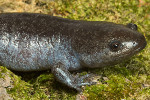
| 
|
| Rare. Relatively large. Color a wash of brown or gray with lichen-like or flecked patterning. Belly bluish-gray (often with a dark stripe running lengthwise). Head noticeably large.
| 
|

| 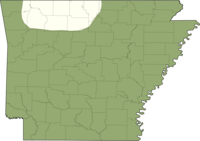
|
| Relatively large. Color a wash of brown or gray with lichen-like patterning. Belly black. Head and mouth noticeably small.
|
|
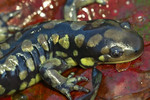
| 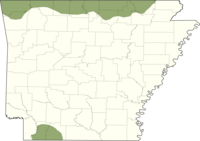
|
| Relatively large. Color a midnight blue to light brown with yellow blotches that form no definite pattern. Belly gray or black with yellow mottling.
| 
|
|
|
Family: Amphiumidae (Amphiumas)
Genus: Amphiuma (Amphiumas)
|

| 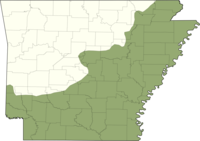
|
| ⚠ Aquatic. Large and eel-like. 4 diminutive limbs with 3 or fewer toes each. External gills absent.
|
|
|
|
Family: Cryptobranchidae (Hellbenders)
Genus: Cryptobranchus (Hellbenders)
|
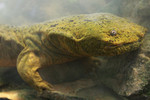
| 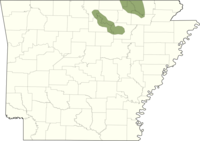
|
| Rare. Very large. Color grayish with dark blotches. Skin highly wrinkled, especially on sides. 4 limbs with 5 toes on each hind foot. External gills absent.
| 
|
|
|
Family: Plethodontidae (Lungless Salamanders)
Genera: Desmognathus (Dusky Salamanders), Eurycea (Brook Salamanders), Hemidactylium (Four-toed Salamanders), and Plethodon (Woodland Salamanders)
|
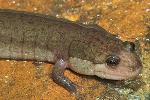
| 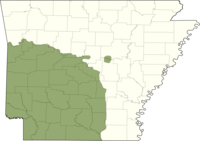
|
| Color brownish to grayish with little patterning. Tail fin-like.
| 
|

| 
|
| Rare and likely ⚠ extirpated from AR. Color brownish to grayish, usually with 6-8 irregular golden ⚠ dorsal blotches. Tail not fin-like.
| 
|
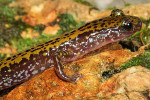
| 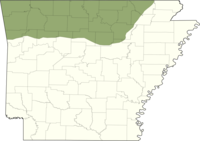
|
| Often found at mouths of caves (or in similar cool, moist habitats). Color yellowish with dark spots. Sides darker and more gray. Sides of tail dark or with somewhat regular, dark, vertical bars.
|
|
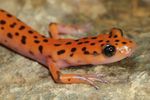
| 
|
| Often found at mouths of caves (or in similar cool, moist habitats). Color bright orange with irregular dark spots. Sides of tail same as body.
|
|
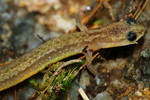
| 
|
| Small. Slender. Color variable, but generally grayish or yellowish. Belly light gray or yellow. Found south of the Arkansas River.
|
|

| 
|
| Small. Slender. Color variable, but generally grayish or yellowish. Belly light gray or yellow. Found south of the Arkansas River.
|
|
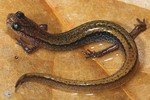
| 
|
| Small. Long and slender. Color bronze. Sides flecked with gray and black. All feet with 4 toes.
| 
|

| 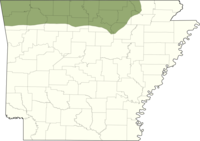
|
| Cave-dweller. Color a ghostly white. Eyes small, beady, and underneath fused eyelids.
| 
|

| 
|
| Cave-dweller. Color a ghostly white. Eyes small, beady, and underneath fused eyelids.
| 
|

| 
|
| Cave-dweller. Color a ghostly white. Eyes small, beady, and underneath fused eyelids.
| 
|

| 
|
| Rare (known in AR only from one locality in the vicinity of Lake Catherine). Neotenic. Similar in appearance to the ⚠ larvae of other Eurycea.
| 
|

| 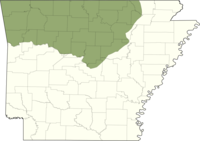
|
| Small. Slender. Color variable, but generally grayish or yellowish. Belly light gray or yellow. Found north of the Arkansas River. Some populations of extreme Northwest Arkansas are neotenic ( ). ).
|
|

| 
|
| Small. Slender. Color variable, but generally grayish or yellowish. Belly light gray or yellow. Found north of the Arkansas River. Some populations of extreme Northwest Arkansas are neotenic ( ). ).
|
|

| 
|
| Rare. Color reddish-brown. Belly pure white with bold, black flecks. Tail thick and round with constriction at base. All feet with 4 toes.
| 
|

| 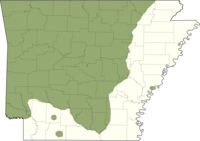
|
| Most common and widely distributed "slimy" in AR. Color black with star-like flecks of white. Chin and belly dark gray. Secretes glue-like slime as defense.
|
|
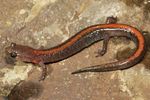
| 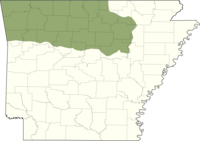
|
| ⚠ Middorsal stripe reddish (sometimes yellowish-green) and zigzagged with irregular margins.
| 
|

| 
|
| Rare and endemic to AR (known only from Caddo Mountain and surrounding areas in Howard, Montgomery, Pike, and Polk counties). Smallish. Color black with numerous star-like brassy flecks. Chin pale. Chest pale and speckled. Belly dark.
| 
|
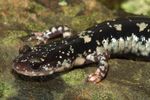
| 
|
| Rare and endemic to AR (known only from Fourche and Irons Fork mountains in Polk and Scott counties). Larger, stockier build than similiar-looking mountain and slimy salamanders. Color black with 2 rows of large, lichen-like blotches and scattered smaller specks. Chin pale. Belly dark with a few white specks.
| 
|

| 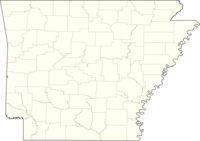
|
| Rare "slimy" (known in AR only from Kiamichi and Round mountains in Polk County). Color black with star-like flecks of white. Chin and belly gray. Secretes glue-like slime as defense.
| 
|
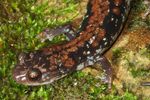
| 
|
| Rare (known in AR only from Rich Mountain and surrounding ridges in Polk County). Color black with lichen-like flecks and a wash of maroon. Chin pale. Chest dark.
| 
|

| 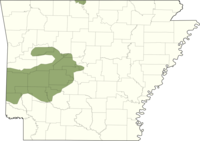
|
| Rare. ⚠ Middorsal stripe reddish-orange with regular margins (each serration matching with a costal groove). Occasional "leadback" individuals without ⚠ middorsal stripe.
| 
|
|
|
Family: Proteidae (Mudpuppies and Waterdogs)
Genus: Necturus (Mudpuppies and Waterdogs)
|
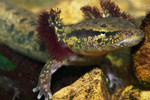
| 
|
| ⚠ Aquatic. Large. Color gray to reddish with dark blotches. Dark stripe through eye. 4 limbs with 4 toes each. External gills large and reddish.
|
|
|
|
Family: Salamandridae (Newts)
Genus: Notophthalmus (Eastern Newts)
|

| 
|
| ⚠ Aquatic (except for ⚠ terrestrial ⚠ eft stage). Color olive and yellowish with many black specks and very few red specks. Dark stripe through eye. Skin rough. External gills absent.
|
|
|
|
Family: Sirenidae (Sirens)
Genus: Siren (Sirens)
|
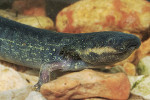
| 
|
| ⚠ Aquatic. Large and somewhat eel-like. Only front limbs present with 4-5 toes each. External gills present.
|
|
|
|
~ Potential Occurrence ~
|

| 
|
| Small. Slender. Color variable, but generally grayish or yellowish. Belly light gray or yellow. Found north of the Arkansas River. Some populations of extreme Northwest Arkansas are neotenic ( ). ).
|
|
|
|
~ Introduced Exotics ~
|
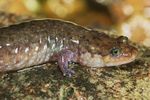
| 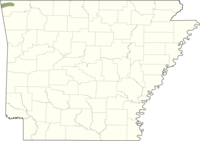
|
| Rare and known in AR only from the Spavinaw Creek drainage in Benton County.
|
|
|
|
|
|
⚠ (:flickrgallery tags="Salamander/Unidentified":)
|